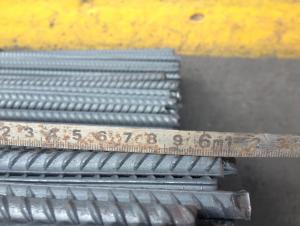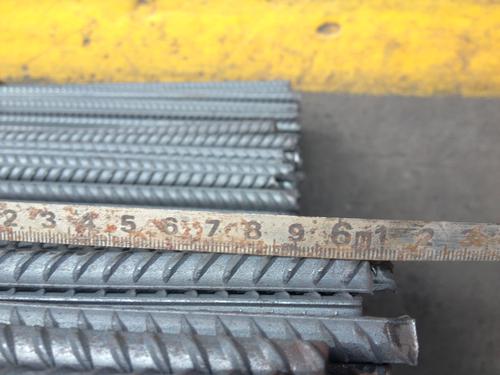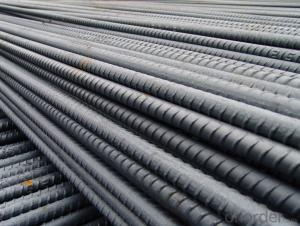Hot Rolled Steel Rebar For Concrete
- Loading Port:
- China Main Port
- Payment Terms:
- TT or LC
- Min Order Qty:
- -
- Supply Capability:
- -
OKorder Service Pledge
OKorder Financial Service
You Might Also Like
Product Description:
OKorder is offering Hot Rolled Steel Rebar For Concrete at great prices with worldwide shipping. Our supplier is a world-class manufacturer of steel, with our products utilized the world over. OKorder annually supplies products to African, South American and Asian markets. We provide quotations within 24 hours of receiving an inquiry and guarantee competitive prices.
Product Applications:
Hot Rolled Steel Rebar For Concrete are ideal for structural applications and are widely used in the construction of buildings and bridges, and the manufacturing, petrochemical, and transportation industries.
Product Advantages:
OKorder's Hot Rolled Steel Rebar For Concrete are durable, strong, and wide variety of sizes.
Main Product Features:
· Premium quality
· Prompt delivery & seaworthy packing (30 days after receiving deposit)
· Can be recycled and reused
· Mill test certification
· Professional Service
· Competitive pricing
Product Specifications:
Manufacture: Hot rolled
Grade: HRB335
Size: 6mm-25mm
Certificates: ISO, SGS, BV, CIQ
Length: 6m – 12m, as per customer request
Packaging: Export packing, nude packing, bundled
Grade | Technical data of the original chemical composition (%) | |||||||
C | Mn | Si | S | P | V | |||
HRB400 | ≤0.25 | ≤1.60 | ≤0.80 | ≤0.045 | ≤0.045 | 0.04-0.12 | ||
Physics capability | ||||||||
Yield Strength(N/cm2) | Tensile Strength(N/cm2) | Elongation (%) | ||||||
≥400 | ≥570 | ≥14 | ||||||
FAQ:
Q1: Why buy Materials & Equipment from OKorder.com?
A1: All products offered byOKorder.com are carefully selected from China's most reliable manufacturing enterprises. Through its ISO certifications, OKorder.com adheres to the highest standards and a commitment to supply chain safety and customer satisfaction.
Q2: How many tons of steel products could be loaded in containers?
A2: Usually the steel products are delivered by bulk vessel because of the large quantity and the freight. However, there are no bulk vessel enter some seaports so that we have to deliver the cargo by containers. The 6m steel product can be loaded in 20FT container, but the quantity is changed according to the size, usually from 18tons to 25tons.
Q3: what is the difference between actual weight and theoretical weight?
A3: All the section steel has two weights: actual weight and theoretical weight. Actual weight is the weighing out when the product delivered from the mill. Theoretical weight is calculated by pieces. The invoice can be based on each of them as your request.
.
Images:
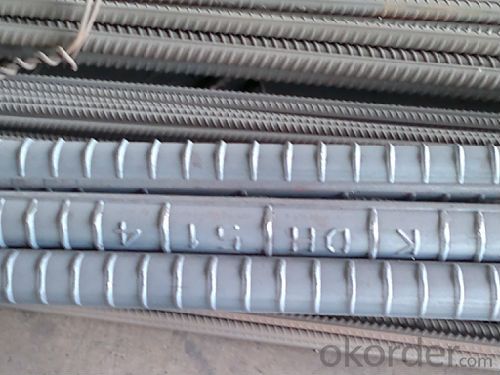
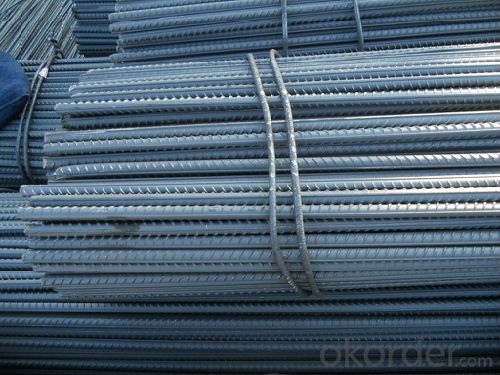
- Q: How are steel rebars protected from damage during handling and transportation?
- Steel rebars are protected from damage during handling and transportation through various methods such as bundling, wrapping, and using protective caps or sleeves. These measures help prevent scratching, bending, and corrosion, ensuring the rebars remain in good condition and ready for use in construction projects.
- Q: What is the role of steel rebars in ensuring occupant safety?
- Various structures, particularly buildings and infrastructure, rely on steel rebars to ensure occupant safety. These reinforced steel bars are commonly used in concrete construction to strengthen and prolong the lifespan of the structure. Ultimately, this safeguards the individuals residing or working within these structures. Steel rebars have a primary function of providing structural reinforcement to concrete elements like columns, beams, and slabs. By incorporating rebars into the concrete, the overall load-bearing capacity of the structure is greatly increased. This allows it to endure external forces and loads, significantly reducing the risk of collapse or structural failure that could harm the occupants. During seismic events, such as earthquakes, steel rebars play a crucial role in dissipating and distributing the energy exerted on the structure. The ductility and tensile strength of steel enable it to absorb and distribute seismic forces, minimizing the chances of a sudden structural failure. Consequently, occupants are protected from potential hazards associated with seismic activity. Additionally, steel rebars enhance the fire resistance of concrete structures. While concrete itself possesses good fire-resistant properties, the inclusion of steel rebars further strengthens this resistance. Steel has a high melting point and low thermal conductivity compared to other materials. This means that steel rebars can withstand high temperatures for an extended period, ensuring the building's structural integrity during a fire and providing occupants with a safe evacuation route. Furthermore, steel rebars contribute to the long-term durability and maintenance of the structure. They prevent cracks and minimize the effects of corrosion, maintaining the concrete's structural integrity over time. This ensures that occupants are not exposed to potential hazards caused by structural deterioration. In summary, the role of steel rebars in ensuring occupant safety is essential. They provide structural reinforcement, increase load-bearing capacity, enhance fire resistance, and contribute to the long-term durability of a structure. By incorporating steel rebars into concrete construction, the risk of collapse, structural failure, and other potential hazards is significantly reduced, ultimately creating a safe environment for occupants.
- Q: Can steel rebars be used in structures with high radiation shielding requirements?
- Steel rebars can indeed be used in structures with high radiation shielding requirements. Steel is known for its excellent strength and durability, making it a popular choice for reinforcing concrete structures. When it comes to radiation shielding, steel rebars can effectively provide a certain level of protection due to their dense composition. While steel itself is not a highly effective radiation shield compared to materials like lead or concrete, it can still contribute to reducing the transmission of radiation. The dense nature of steel helps to scatter and absorb some of the radiation passing through the structure, thereby reducing the overall exposure. However, it's important to note that for structures with extremely high radiation shielding requirements, additional measures may be necessary. These could include incorporating other radiation-absorbing materials like lead or concrete, or implementing specific design features to enhance the shielding capabilities of the structure. Ultimately, the choice of materials and design considerations should be made in consultation with radiation safety experts and engineers who can assess the specific shielding requirements and recommend the most appropriate solutions.
- Q: What are the different types of coatings available for steel rebars to prevent corrosion?
- There are several types of coatings available for steel rebars to prevent corrosion. These include epoxy coatings, zinc coatings, galvanized coatings, and polyethylene coatings. Each coating has its own unique properties and level of protection against corrosion.
- Q: How do steel rebars contribute to the fire resistance of a building?
- Steel rebars contribute to the fire resistance of a building by providing reinforcement to the concrete elements. When exposed to high temperatures during a fire, steel rebars do not melt or lose their structural integrity easily. Instead, they conduct heat away from the fire, slowing down the transfer of heat to the surrounding concrete. This delays the loss of strength and structural stability of the building, giving occupants more time to evacuate and firefighters more time to control the fire.
- Q: What are the common surface patterns for steel rebars?
- Some common surface patterns for steel rebars include plain, deformed, and ribbed patterns.
- Q: Can steel rebars be painted or coated?
- Steel rebars can indeed be painted or coated, a common practice in construction and engineering for protecting against corrosion and enhancing their appearance. The procedure involves applying a layer of paint or coating substance onto the rebars' surface. This protective layer acts as a barrier, preventing moisture and other corrosive elements from reaching the steel, thereby extending the rebars' lifespan. Furthermore, painting or coating the rebars aids in distinguishing them from other construction materials or facilitating color-coded identification. It is crucial to utilize top-notch paint or coating materials specifically formulated for steel applications to ensure adequate adhesion and durability.
- Q: Can steel rebars be used in structures with high wind loads?
- Yes, steel rebars can be used in structures with high wind loads. Steel rebars have high tensile strength and can effectively reinforce concrete structures, making them more resistant to wind-induced forces and providing the necessary structural stability.
- Q: How are steel rebars transported to the construction site?
- Various methods are employed for the transportation of steel rebars, also known as reinforcing bars, to construction sites. One commonly used approach involves the use of trucks. The rebars are loaded onto flatbed trucks or trailers and firmly secured with straps or chains to prevent any shifting during transit. These trucks are specially designed to withstand the weight and length of the rebars, boasting robust frames and loading mechanisms. Another method is rail transportation. Steel rebars can be loaded onto rail cars, either on flatcars or in specialized containers, and transported to the construction site. This method proves particularly advantageous for long-distance transportation, as it offers a more cost-effective and efficient solution for large quantities of rebars. For construction projects situated near waterways, the transportation of rebars can also be accomplished by sea or barge. The rebars are loaded onto ships or barges and properly secured to prevent any damage or movement during transit. This method is commonly employed for projects necessitating substantial quantities of rebars or for construction sites located on islands or in coastal areas. Upon arrival at the construction site, cranes or forklifts are typically utilized to unload the steel rebars. These rebars are then either stored in designated areas or immediately employed for reinforcement in the construction process. It is of utmost importance to handle the transportation of rebars with caution, as this ensures their structural integrity and guards against potential accidents or damage during transit.
- Q: How do steel rebars impact the overall aesthetics of concrete structures?
- The overall aesthetics of concrete structures are greatly influenced by steel rebars. Concrete is known for its strength and durability, but it lacks the ability to resist bending or stretching forces. This is where steel rebars come in. By reinforcing concrete with steel rebars, the structural integrity of the concrete is greatly improved. This allows engineers and architects to design more complex and ambitious structures, such as high-rise buildings, bridges, and stadiums. The use of steel rebars provides the necessary strength and flexibility to withstand heavy loads, seismic activity, and other environmental forces. However, the presence of steel rebars can impact the appearance of the concrete structure. In some cases, especially in exposed concrete finishes, the visibility of steel rebars can be seen as a visual distraction or an undesirable element. The exposed steel rebars may create a grid-like pattern or a rusty appearance, which can be perceived as unattractive or out of harmony with the surrounding environment. To address this aesthetic impact, various techniques are employed. One common approach is to use concrete coverings or coatings to hide the steel rebars and create a smooth and uniform surface. These coverings not only improve the appearance but also protect against corrosion and prolong the lifespan of the structure. Another method is to use decorative techniques like formwork or molds to create unique patterns or textures on the concrete surface. This way, the steel rebars are concealed within the design, enhancing the overall aesthetic appeal of the structure. By incorporating architectural features such as curves or geometric shapes, the presence of steel rebars can be turned into a visual asset instead of a hindrance. It is important to note that in certain architectural styles, like Brutalism, the raw and exposed nature of concrete structures, including the visibility of steel rebars, is celebrated as an artistic expression. In these cases, the industrial and utilitarian aesthetic is embraced, and the steel rebars become an integral part of the overall design concept. In conclusion, steel rebars have a significant impact on the aesthetics of concrete structures. While their presence can sometimes hinder achieving the desired visual outcome, various techniques and design approaches can be used to either conceal or incorporate steel rebars into the overall architectural design, resulting in visually pleasing and structurally sound concrete structures.
Send your message to us
Hot Rolled Steel Rebar For Concrete
- Loading Port:
- China Main Port
- Payment Terms:
- TT or LC
- Min Order Qty:
- -
- Supply Capability:
- -
OKorder Service Pledge
OKorder Financial Service
Similar products
Hot products
Hot Searches
Related keywords
